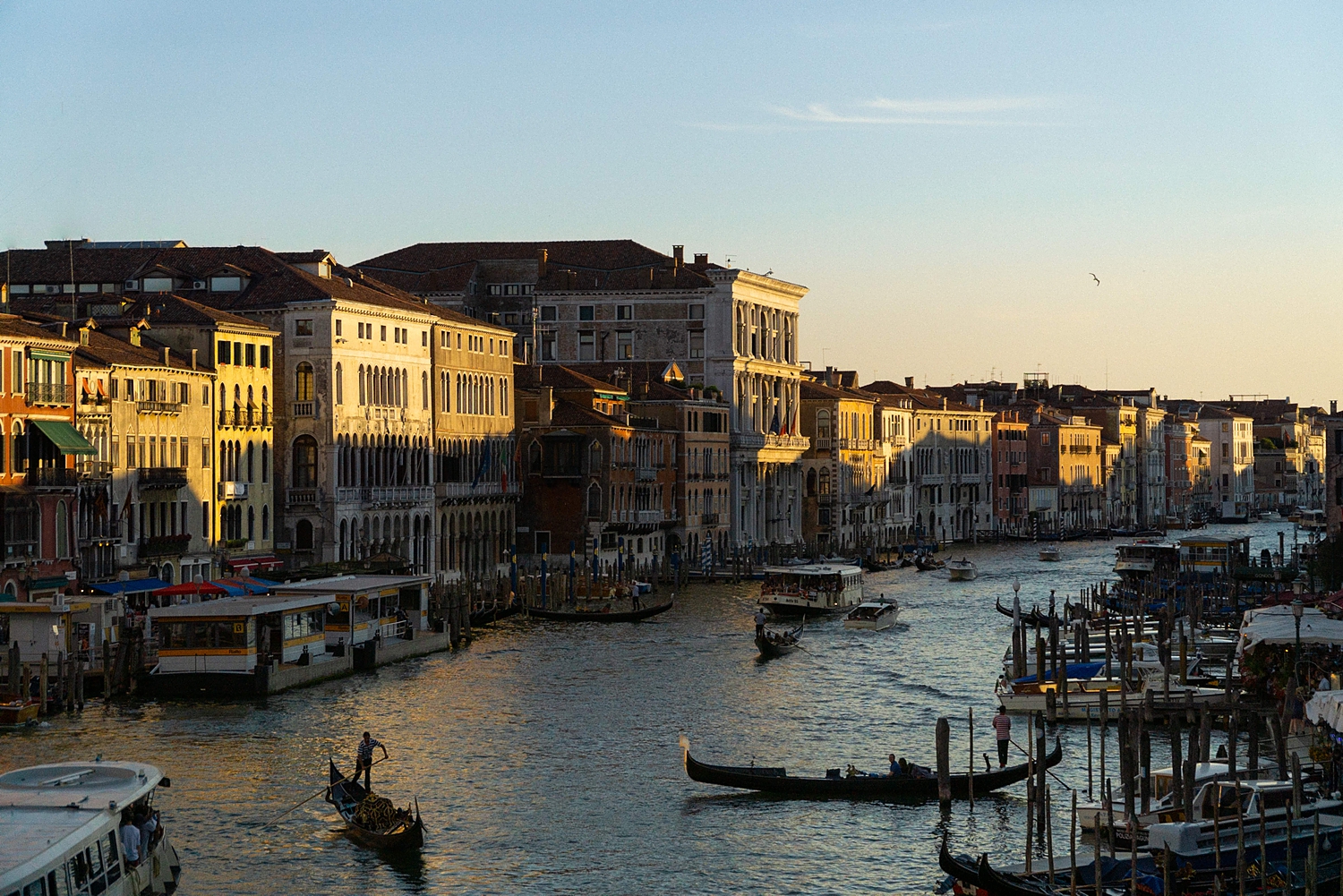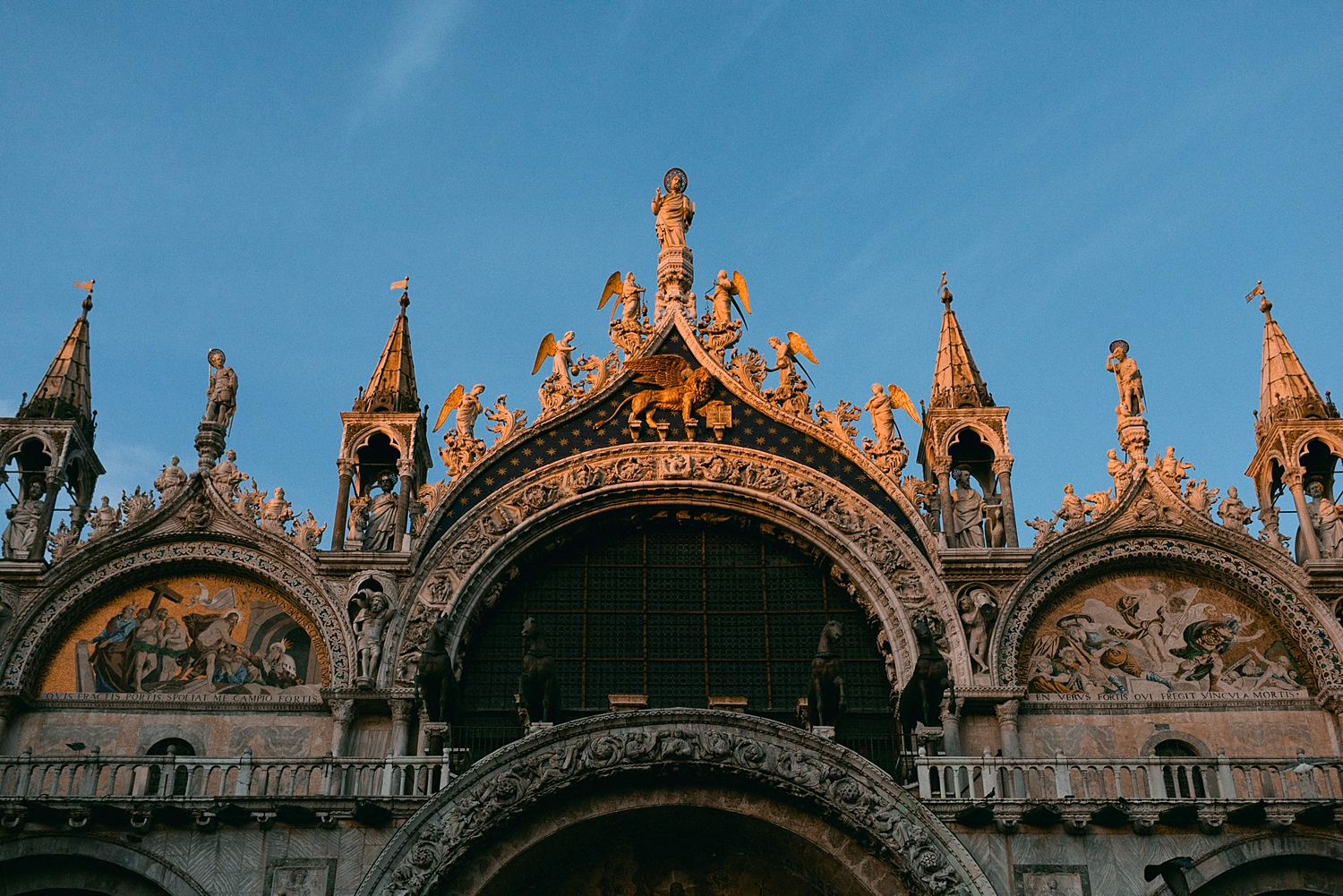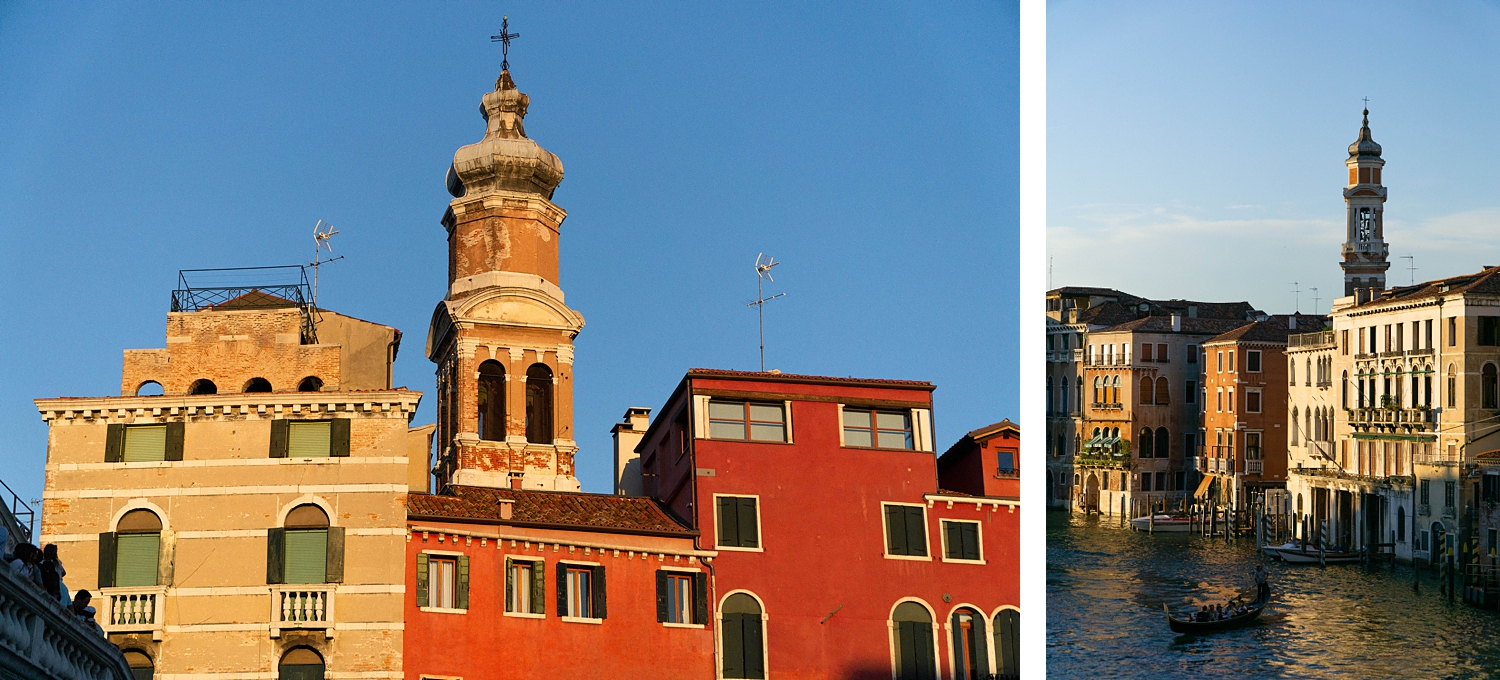Venice, Italy Visitors Guide and Photo Tour
 The busy Grand Canal of Venice, Italy at sunset.
The busy Grand Canal of Venice, Italy at sunset.
Venice, Italy
At its best, Venice is the most romantic city on earth. A sparkling jewel floating in a blue Adriatic lagoon. At its worst, it’s a congested tourist trap… Hot and full of cruise ship passengers in capri pants blindly following tour guides. In some sense, almost everywhere in Italy has this duality. In Venice, it’s exaggerated by the same things that make the city magical. The small size of the city, narrow walkways, and its top bucket list destination status. But these problems can fixed with a little research and planning. Underneath it all, Venice is still the magical city it has always been.
Don’t fall for Piazza San Marco. The iconic area is of course deserving of a visit… But I would not recommend staying anywhere near it. During the day, the area around the Piazza is filled with tourists and those trying to get their money. It’s a nightmare. Instead, come here at sunrise for photos (with less people), and in the evening to hang out.
When To Visit Venice
Venice is always great, but there are ideal times for visiting. Summer gets hot, humid, and crowded. Tourists pack in by the thousands. Winter, though less crowded, can get pretty cold and rainy. It is also when flooding is most likely. Unless you like touring the city up to your knees in water, you’ll want to stere clear if possible. Though if you are feeling adventurous, you can live like a local. Spring and Fall are perfect times to visit. The temps are usually mild and there are less visitors.
 A smaller canal runs by Ca’ Rezzonico, a palazzo on the Grand Canal.
A smaller canal runs by Ca’ Rezzonico, a palazzo on the Grand Canal.
Where To Stay In Venice, Italy
Consider staying on a different part of the island entirely than Piazza San Marco. It’s the hub of tourist activity after all. Try staying close to the train station if you are thinking of exploring the mainland. A hotel on the Grand Canal is always great. There is lots of nearby transportation, restaurants, and lively scenery.
Consider a small locally run hotel. These offer helpful, friendly service and guidance. They can be a value or luxurious depending on your budget. I would also consider some of the larger hotel chains before a rental. They are often in good locations and employ many locals.
Look at vacation rentals last. Yes, there are some great deals in awesome places… but they are often owned by outsiders who buy up homes from locals who can’t afford them anymore. These places sit empty in the off season and contribute to the shrinking population of the city. After all, there is only so much land and real estate on an island like Venice. See some of my favorite hotel recommendations below.
 The colorful city of Burano, Italy.
The colorful city of Burano, Italy.
Exploring The Venetian Lagoon
Get out of the city. Yes, Venice is incredible, but there are nearby communities worth checking out too. My favorite is Burano; this island village is famous for its colorful buildings. It’s the most photogenic place you’ve ever seen. Tourists know about Burano too though. Plan on visiting in the late afternoon; around 5pm, the tourist all take off and the locals come out. The sunsets are magical here. This is a perfect setting for unforgettable photos; plan on grabbing dinner and take it all in.
Murano is famous for its glass making culture. To be honest, if you are not into glassblowing and glass art, I’d skip Murano. The architecture is pretty uniform and it gets packed with tourist during the day. Though, If you do get excited by glass art, I imagine this place is quite thrilling.
Instead of Murano, I’d suggest a trip to the beach. The barrier islands of the Venitian Lagoon have some great beaches. Lido is a short boat ride from Venice. Walking from the lagoon side to the Adriatic side of the island only takes a few minutes. The public beaches do get crowded during nice days but there is plenty of room in the water.
 Lido Beach filled with sunbathers.
Lido Beach filled with sunbathers.
Venice Cuisine
Speaking of eating, Venice has plenty of world class cuisine. Yes, you can find great pizza and lasagna in Venice, Italy. Though if you want to truly experience the local culture, it’s all about seafood! Most restaurants get their ingredients fresh from the lagoon daily. Be sure to consider to daily specials for that reason. If you are new to this kind of cuisine, tell the chef and ask them to surprise you. They will almost always be happy and excited to show off what makes their food special.
If you are the kind of person who likes a big breakfast to get your day started, plan ahead. Italians don’t like heavy breakfast… So it can be hard to find anything but coffee and pastries before lunch. Be sure to get that coffee though, it’s fantastic.
Again, don’t be afraid to get off the beaten path. Many of the restaurants near the tourist hot spots will cater to them. That means less creative and more americanized dishes (cheese pizza anyone?). You can often spot these places by the photos of food in the window, usually captioned in english. Of course today, you can check up on any business by searching online. Try to focus on the reviews and lists by qualified journalist or publications. I always avoid review sites like Yelp. You can never be sure what those reviewers agendas might be.
 The Gothic roofline of San Mark’s Basilica.
The Gothic roofline of San Mark’s Basilica.
A Step Back In Time
Part of what makes Venice unique is how unchanged it has remained for centuries. It might be cliche, but it can feel like taking a step back in time. Venice architecture is the most visible proof of this. Once the capital of a powerful maritime empire, Venice imported styles from around the globe. There is a unique mix of Byzantine, Roman, Gothic, and Ottoman influences. Venice played a prominent role in the Italian Renaissance as well and it is well represented too. The cherry on top of this stylistic ensemble is the extravagance of the 1700s. This was the period of Venetian decline as a business and political power. It dove into hedonistic pleasures and spending its fortune on decadence. The resulting Rococo style of this era is therefor marked by excessive luxury. It is in large part what Venice is best known for today.
Venice is of course home to one of the worlds greatest concentrations of fine art. This is a blessing and a curse for the city. It allowed Venice to remain a must see destination over the centuries. Tourists came bringing money and prestige to the city. Wealthy outsiders have bought property and raised prices for locals. Many have had to move to the mainland in search of more affordable living.
The hordes of sightseers have caused irreparable damage to Venetian treasures. Cruise ships have also polluted and disrupted the lagoon’s fragile ecosystem. They deposit upwards of 30,000 day trippers to the tiny islands. August and July are the worst. It can be a struggle to walk from one side of San Marco square to the other. This is an ongoing struggle for the people of Venice. Additionally, rising sea levels and a sinking islands cause worse and worse flooding.
All these factors together threaten the very existence of the lagoon. It is important to note this when visiting. Always follow the rules and restrictions. Be an educated and responsible (temporary) resident of Venice.

Getting Around Venice Italy
Though many mourn the Venice of old, the city still retains the magic of its past, if you know where and when to look. This is never more true than at night. Make a point to wonder around the deserted streets after dark. It’s beautiful and a little eerie (in a good way). Remember to bring some comfortable shoes though. Venice is truly one of the best walking cities on earth. You won’t find anything with wheels to get in your way here. No cars, bikes, scooters, or skateboards. Venice is small compared to many other great cities. It’s also an island. Therefor don’t worry about getting lost… You’ll eventually find your way home.
If you are not feeling up for a hike, or if you want to visit a different island, you’re going to need to hop on a boat. What kind of boat you choose depends on what you need it to do. Gondolas are famous but pricy and slow for simply getting around. It’s worth splurging on at least once though. Try going around sunset or night and make it a romantic experience.
Water buses, or Vaporetti, are cheap and take you around the city and through the Grand Canal. They also shuttle passengers to other islands. Be sure to check the schedules in advance though. Service slows in the evening and may require transfers.
Water taxis are your speediest option but are also much more expensive than a bus. This is especially true when heading to other islands. Again, it can be worth it to take a taxi at least once. The boats are often beautiful wooden craft that make for good photo ops.
Let’s Go
I often hear that a day or two is plenty for a visit to Venice, Italy. I honestly think that advice comes from those who have only grazed the touristy surface of the city. Yes, like a cruise ship passenger, you can hit the highlights in a day… But you’ll be leaving without ever seeing the real Venice.
Stay somewhere far away from San Marco Square. Explore the various neighborhoods at different times of the day. Ask locals for advice on places to eat and things to do. Actually go INSIDE one of the many museums or churches. Attend a dinner opera or festival. See how long you can go without stepping food into a souvenir shop. Go to Burano. Visit the beach. Wonder the streets. Basing your entire trip in the Lagoon will be time well spent. Dig into the history, culture, and spectacle .
Like any worthwhile city, dualities exist in Venice. In the end, the good far outweighs the bad, and the bad is better than almost anywhere else on it’s best day. Go.






































Venice, Italy Travel Recommendations
Venice Accommodations:
Venice Area Restaurants:
Boccadoro
Locanda Cipriani
Al Covo
La Perla ai Bisatei
Trattoria da Romano
Antiche Carampane
Osteria Alle Testiere
La Zucca
Osteria Alla Fresca
Antiche Carampane
Trattoria Al Gatto Nero
La Favorita
Things To Do In Venice, Italy
Take an evening gondola ride.
Visit the Piazza San Marco in the late evening.
Tour Doge’s Palace and the Correr Civic Museum.
Kayak through the canals.
Grab a spot on the Rialto Bridge for sunset.
Check out the view from the Church of San Giorgio Maggiore’s campanile.
See a concert at the Teatro La Fenice Opera House.
View the stunning Basilica di Santa Maria della Salute.
Wander the Rialto Bridge’s food market.
Take in some of Renaissance master Paolo Tiepolo’s greatest works at the church of San Sebastiano.
Dive into the Adriatic Sea at Lido Beach.
Tour the Gallerie dell’Accademia.
See the flooded crypt of San Zaccaria.
Nearby Destinations
Burano
Torcello
Lido Island
Murano (if you like glass)
Day Trips From Venice, Italy
Verona
Lake Garda
The Dolomites
Padua
Vicenza
Trieste
Ravenna
Mantua
Considering getting married or eloping in Italy? Take a look at my guide to the best wedding venues in Italy. Then, get to know me and get in touch.
Comments +